Rhubarb
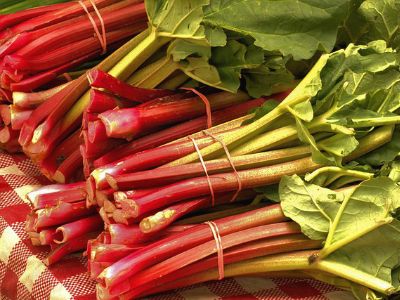
Preparation: Step-by-Step
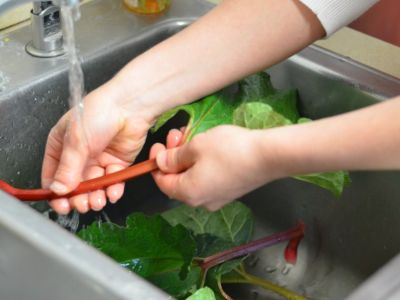
Wash hands. Thoroughly rinse stalks to remove any dirt or sand.
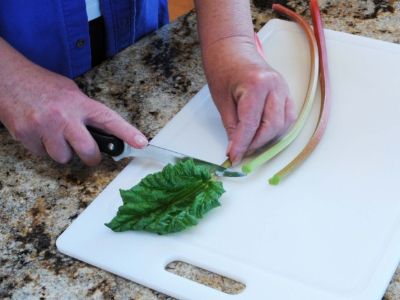
Cut off leaves and end of stem using a knife. Remove blemishes with a paring knife.
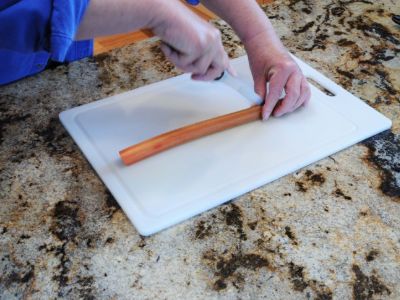
For stalks wider than one inch, slice stem in half. For fibrous stalks, remove strings by cutting just under the skin and pulling the string down the stalk. Continue until all strings are removed.
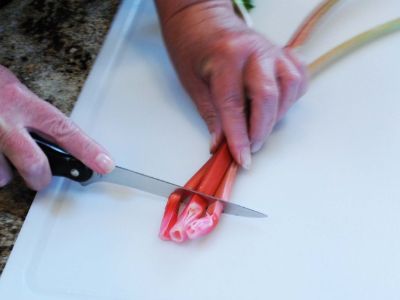
Cut stalks into 3/4- to 1-inch pieces for use in stews or sauces. For use in pies, use 1/4- to 1/2-inch pieces.
Grow.
- Technically a vegetable, rhubarb or “pie plant” can produce for 20 or more years and
grows to a size of two feet high and six feet wide. To allow enough space for the
mature plant, dig a hole two feet around and at least one foot deep. Add compost and
plant crowns three feet apart at a depth of 2-3 inches below the soil surface. Water
and cover with a layer of mulch.
Visit msuextension.org for more information or contact your local MSU Extension office.
Harvest.
- A mature rhubarb plant can produce up to six pounds of stalks in a season. For the first two years after planting, harvest stalks sparingly, taking only a few at a time and only for a few weeks throughout the season. In the third growing season, harvest as much as you like from spring through the first part of July or until stalks begin to become smaller in diameter.
- Rhubarb can be red, partially-red or green. The deeper the red, the more flavorful the stalks. Medium-size stalks are generally more tender than large ones, which may be stringy. Choose firm stalks which are not shriveled or limp. Only the stems are edible. Leaves should be discarded because they are poisonous. The stalks do not need to be completely blemish-free. Damaged spots can be trimmed away.
- For storage, first trim and discard leaves. Freshly harvested stalks can be kept in the refrigerator, unwashed and wrapped tightly in plastic for up to three weeks. Refresh rhubarb stalks by standing them in a pitcher that has been filled partially with cold water. Allow them to stand for a minimum of one hour.
- Most fruits are rich in fiber and phytochemicals, but provide negligible amounts of saturated fat, trans fat, cholesterol, and sodium and are gluten-free. Rhubarb has only 13 calories per half-cup serving and is rich in Vitamin C.
Bake.
- Use in recipes for jams, jellies, desserts, quick breads, juice and pies.
Sauce.
- Rinse and cut the stalks into 1-2 inch pieces and add 3/4-cup of water per four cups of rhubarb. Bring to a boil and simmer until tender. Since rhubarb is acidic, use a pan that will not cause color change or chemical leakage from cookware. These pans are call “non-reactive pans” and include aluminum, stainless steel, Teflon coated aluminum, or enamel-coated cast iron. Pans causing reactions to highly acidic foods such as rhubarb, are iron, steel, and aluminum. Rhubarb sauce is excellent as a topping for ice cream, pancakes, waffles, pound cake, a bowl of fresh fruit, gingerbread or yogurt. Add sugar if desired. Sauce will keep in the refrigerator up to four days.
Preserve.
- For information on preserving fruits, look for the MSU Extension MontGuides: Freezing Fruit; Drying Fruit; Processing Fruit and Tomato Products in a Pressure Canner; Making Jams, Jellies, and Syrups. Visit msuextension.org for more information or call your MSU Extension office.
For More Information:
Montana State University Extension: msuextension.org
MSU Extension Master Gardener: mtmastergardener.org
MSU Extension Food and Nutrition: nutrition.msuextension.org
MSU Extension Nutrition Education Programs: buyeatlivebetter.org
Date of Publication: January 2014
